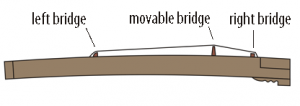Skype online Lessons for Chinese Music Instruments
March 8, 2016Chinese Instruments Moving Out Sale!
March 31, 2016What is a Guzheng?
The Guzheng, known to be a highly expressive instrument capable of performing glissando, chords and melody lines due to how the instrument is designed.
Today, we will be sharing with you about the different parts of the Guzheng that made it visually elegant as well as practically versatile.
The guzheng’s main body is made up of a rectangular hollow wooden box, with the top surface protruding at a certain degree. On top of the body, are strings tied across the 2 bridges at the left and right ends of the the body.
Tuning pins under the right bridge
Different bridges of the guzheng
The left end, traditionally labeled the 鳳尾 (fèng wěi), meaning the phoenix tail, is where the bridge forms an S shape. On the other hand, the bridge on the right end, where the player plucks the strings, is straight and vertical. Under the bridge lies the tuning pins, where each string can be tightened or loosened using the tuning wrench to tune to the corresponding pitch. An alternative to adjusting the pitch of the strings would be to adjust the bridges supporting the strings that run across the main body.
A 26-string Guzheng
While the most commonly seen Guzhengs today are made up of 21 strings, there are also 16, 18, or even 26 strings variants. And to no surprise, there are also different types of strings, made of different materials such as steel, nylon-steel, and even silk. Such varieties arise from the different wwwelopments of the instrument originating different regions.
Like any other musical instruments, the pitch of each string varies due to thickness, with the thicker string producing lower pitches and thinner strings producing higher pitches. For the Guzheng, strings of the higher pitch range are those nearer to the player, and they are numbered from 1 to 21 (or the total number of strings that Guzheng have, respectively) from the thinnest to the thickest string. Similar to the harp, this is what enables a player to perform a glissando on the Guzheng.
Finally, pressing the string on the left of the movable bridge increases the tension of the strings, producing notes of a slightly higher pitch than that of the string’s designated note. On top of letting performers play notes that are not tuned in the pentatonic scales, this also helps the performer to showcase a unique oriental style which is not possible with many other instruments.
Check out the Guzhengs we have in store here and our music lessons here!








